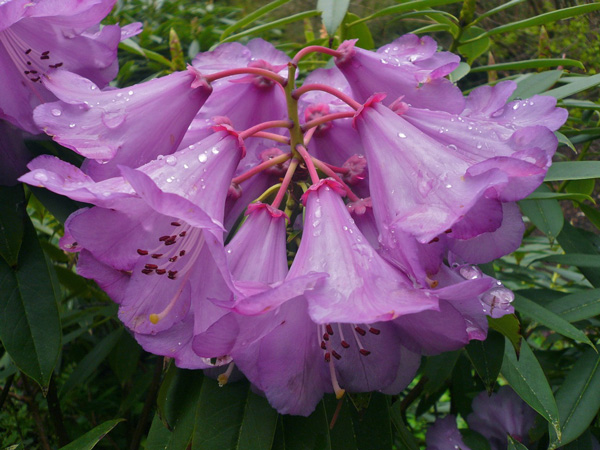Like last year, we’re well on the way to one of the warmest springs in recent memory. A number of plants flowered two to three weeks early and many familiar April-blooming plants long since put out their flowers (how about those magnolias and cherries?). But again like last year, there are plenty of plants sitting tight, waiting to flower as they normally would—or at least within only a week or two of their usual time. On this list of conservative bloomers are many in the genus Rhododendron, a group of plants that numbers around four hundred and fifty species varieties and cultivars in the Garden.

Rhododendron huanum with its clean, narrow, grass green foliage and purple flared-edged flowers with a small dark calyx.
Last year at this time I outlined a rough classification of rhododendrons and this is repeated and elaborated here. The cultivated, temperate rhododendrons fit more or less into four main groups: deciduous and evergreen azaleas, lepidote (scaly-leaved) rhododendrons and elepidote (non-scaly-leaved) rhododendrons. The lepidotes, were the subject of last April’s article. They are certainly worth seeking out, as are the azaleas, two separate groups of non-scaly rhododendrons also covered briefly last year. The bulk of the Botanical Garden’s rhododendron collection consists of elepidotes. These are the mostly larger, larger-leaved and more familiar rhododendrons of commerce, although most conventional nursery and garden centre sales are of elepidote hybrids, rather than the wild species you will see in the Botanical Garden. Within the elepidote group, there are some two dozen subgroups, representing variations in flower and fruit structure, leaf shape and leaf hair characteristics.
Plants in the Fortunea group are among the most numerous in the garden, and are also arguably some of the toughest and most rewarding large rhododendrons that can be grown in the Vancouver area. This group includes plants that are often moderately large leafed and large flowered, and that bloom over a long season. Most will be in bloom at some point in April. Few visitors walk away unimpressed by the arboreal grandeur of R. diaprepes. Our specimen of ‘Gargantua’ on Tschonoski Trail is now well over 12 m tall and it towers above other huge rhododendrons. Likewise, the sweetly scented and opulent flowers of R. griffithianum (Lower Asian Way between Soulie and Wharton Trails) whose superlative genetics are famously displayed in the Loder hybrids, attracts considerable attention. On a slightly smaller scale, there are numerous examples of the similar looking R. fortunei and R. decorum throughout the Asian Garden. Both are large shrubs with white to pale pink, scented flowers. Some selections of the closely related R. discolor produce sizable trusses of magenta and white flowers around this time.
At the western end of Lower Asian Way, garden visitors are met with a wall of 6 m high R. vernicosum plants. Continuing eastward along this path, Wharton collections of R. glandulosum and R. serotinum are now clearly showing their tree-like inclinations, but these may not show their flowers until May or even later (but one never knows). The related R. maoerense (west of Meyer Glade) flowers earlier with huge sticky, sweetly fragrant pink flowers and will likewise become arborescent with time. Of the shrubbier species, R. orbiculare (Lower Asian Way between Soulie and Wharton Trails) is a crowd favourite. Its ample rounded leaves and bulging, hot pink bells are extraordinarily handsome, alone, or particularly together. Another standout is R. oreodoxa var. fargesii (numerous plants along Lower Asian Way) with its abundant lax trusses of softly ruffled, pink flowers. Two of the most exciting new introductions in this group are R. huanum with its clean, narrow, grass green foliage and its purple flared-edged flowers with a small dark calyx (plants on Ludlow Trail and Henry Trail), and the ample, wavy-leaved, R. yuefengense, with its lovely pink bells. Look for this rare species on the top of Moulan Shan (magnolia mountain) where Hemsley and Maack Trails coincide.
More pictures of April in the Garden can be found on our Forums.
Submitted by Douglas Justice, Associate Director of Horticulture and Collections, April 1, 2016
